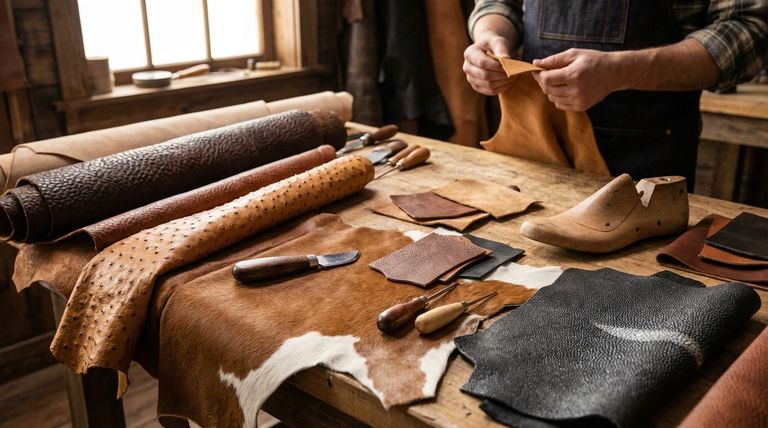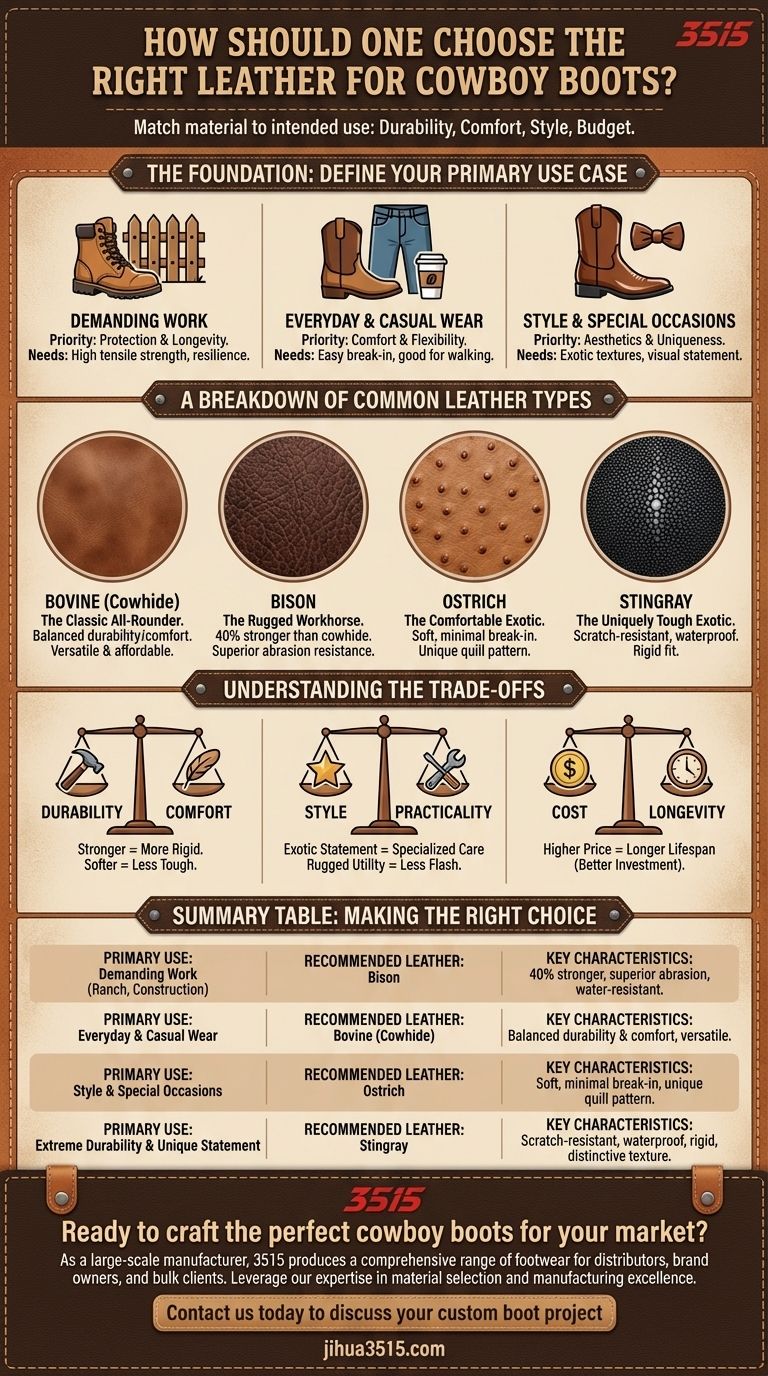Choosing the right leather for cowboy boots is about matching the material directly to your intended use. The decision hinges on three core factors: the durability required for your activities, the level of comfort you expect, and the aesthetic you want to achieve, all balanced against your budget.
The ideal leather isn't a single "best" type, but rather a calculated trade-off. Your choice should align with the boot's primary function—whether for demanding work, casual wear, or special occasions—as this will dictate the importance of durability, comfort, and style.

The Foundation: Define Your Primary Use Case
Before comparing specific leathers, you must clarify how you will wear your boots. The environment and activity level are the most important factors in your decision.
For Demanding Work Environments
If your boots are for ranch work, construction, or other rugged jobs, your priority is protection and longevity. The leather must withstand abrasion, impacts, and harsh conditions.
Look for materials known for their tensile strength and natural resilience. This is where practicality must always come before style.
For Everyday and Casual Wear
For daily use, comfort and flexibility become much more important. While durability still matters, you'll want a leather that breaks in easily and feels good for long periods of walking or standing.
This is where you can balance a material's practical qualities with its look and feel, allowing personal style to play a larger role.
For Style and Special Occasions
When boots are part of a specific look or reserved for events, aesthetics and uniqueness are the primary drivers. Exotic leathers with distinct textures and patterns shine in this category.
Here, the focus shifts from pure function to the visual statement the boots make.
A Breakdown of Common Leather Types
Each leather has a distinct personality and set of characteristics. Understanding them is key to making an informed choice.
Bovine (Cowhide): The Classic All-Rounder
Cowhide is the traditional, go-to material for cowboy boots. It offers a fantastic balance of durability, comfort, and affordability.
It's a versatile choice that can be finished in many ways, making it suitable for both work and casual wear. It provides a reliable baseline for performance.
Bison: The Rugged Workhorse
Bison leather is exceptionally strong and durable, rated as much as 40% stronger than traditional cowhide. Its rigid, interlocking fibers offer superior protection.
It features a unique, deep grain pattern that distinguishes it visually. Its natural oils also provide a degree of water resistance, making it an excellent choice for tough, outdoor use.
Ostrich: The Comfortable Exotic
Ostrich is prized for its distinct "quill" pattern and vibrant appearance. More importantly, it is one of the softest and most comfortable exotic leathers available.
Boots made from ostrich often require a minimal break-in period, making them an outstanding choice for those who prioritize immediate comfort alongside a high-end look.
Stingray: The Uniquely Tough Exotic
Stingray skin is one of the most durable and scratch-resistant leathers in the world. Its surface is covered in hard, calcium-based pearls, giving it a unique gravelly texture.
While incredibly tough and waterproof, it is also rigid and difficult for bootmakers to work with. This makes it a bold, protective, but less common option.
Understanding the Trade-offs
Choosing a boot leather is an exercise in balancing competing benefits. There is no single material that excels in every category.
Durability vs. Comfort
The strongest leathers, like bison and stingray, are often more rigid initially and may require a longer break-in period. Softer leathers like ostrich offer out-of-the-box comfort but may not be as suitable for abrasive, heavy-duty work.
Style vs. Practicality
Exotic leathers make a powerful style statement but often require more specialized care. Their unique textures might be damaged in a harsh work environment where a rugged cowhide or bison boot would thrive.
Cost vs. Longevity
High-performance and exotic leathers come with a higher price tag. However, the superior durability of a material like bison can mean a longer lifespan for a work boot, making it a better long-term investment.
Making the Right Choice for Your Goal
Filter your options through your primary need to find the perfect material.
- If your primary focus is maximum durability for work: Choose bison leather for its superior strength and resilience in harsh conditions.
- If your primary focus is classic style and versatility: Traditional cowhide offers a reliable and proven balance of durability, comfort, and value.
- If your primary focus is immediate comfort and a unique look: Ostrich leather is an excellent choice that combines exotic style with a soft, supple feel.
- If your primary focus is extreme scratch-resistance and a bold statement: Consider stingray for its unparalleled toughness, but be prepared for a rigid fit.
Ultimately, the best leather is the one that serves your daily needs without compromising your personal style.
Summary Table:
| Primary Use | Recommended Leather | Key Characteristics |
|---|---|---|
| Demanding Work (Ranch, Construction) | Bison | 40% stronger than cowhide, superior abrasion resistance, water-resistant |
| Everyday & Casual Wear | Bovine (Cowhide) | Balanced durability & comfort, versatile, affordable |
| Style & Special Occasions | Ostrich | Soft, minimal break-in, unique quill pattern, high-end look |
| Extreme Durability & Unique Statement | Stingray | Scratch-resistant, waterproof, rigid, distinctive texture |
Ready to craft the perfect cowboy boots for your market?
As a large-scale manufacturer, 3515 produces a comprehensive range of footwear for distributors, brand owners, and bulk clients. Our production capabilities encompass all types of shoes and boots, ensuring you get the right leather and construction for your customers' needs—whether for rugged work, casual wear, or high-fashion statements.
Contact us today to discuss your custom boot project and leverage our expertise in material selection and manufacturing excellence.
Visual Guide

Related Products
- Safety Footwear Wholesale Manufacturer for Custom OEM/ODM Production
- Wholesale Safety Footwear Manufacturer for Bulk & Custom OEM Orders
- Premium Wholesale Waterproof Safety Boots High Performance Protection for Industrial Markets
- Premium Grain Leather Safety Boots for Bulk Supply
- Customizable Anti-Smash Safety Boots for Wholesale & Private Label Manufacturing
People Also Ask
- Do snake bite boots work? Your Ultimate Guide to Effective Snake Bite Protection
- What are the differences between steel toe, composite toe, and alloy toe Wellington boots? Choose the Right Safety Toe for Your Job
- What are OSHA approved shoes? Understanding the Correct Standards for Workplace Safety
- What cultural and environmental considerations are tied to wearing shoes indoors? Balance Hygiene, Tradition, and Foot Health
- How long can you wear safety boots? The Lifespan is Determined by Wear, Not Time



















